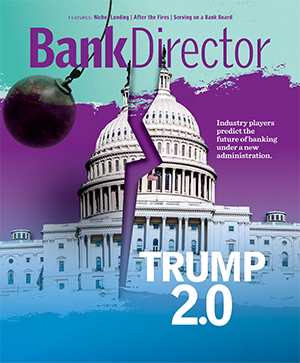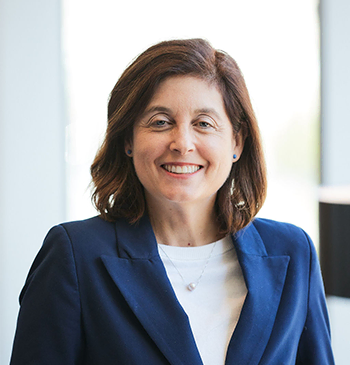Editor-in-Chief Naomi Snyder is in charge of the editorial coverage at Bank Director. She oversees the magazine and the editorial team’s efforts on the Bank Director website, newsletter and special projects. She has more than two decades of experience in business journalism and spent 15 years as a newspaper reporter. She has a master’s degree in journalism from the University of Illinois and a bachelor’s degree from the University of Michigan.

Although DEI Is Under Attack, Some Directors Remain Committed
The term “DEI” may be toxic, but some board members say they’re not giving up on diversity efforts.
As President Donald Trump’s administration ramps up efforts to end “illegal” discrimination and diversity, equity and inclusion programs, many large banks such as Citigroup or Bank of America Corp. have publicly retreated from efforts to improve diversity. Some public banks have stripped references to DEI from their annual reports or websites, despite having previously identified DEI as “foundational,” for example.
But smaller banks face less public scrutiny and may do less federal contracting work than the big banks do. Many of them have said in recent weeks that they’re not pulling back on diversity efforts. Julie Young, an employment attorney and a director at $6.2 billion CNB Financial Corp. in Clearfield, Pennsylvania, gave an interview for Bank Director magazine’s upcoming issue where she says DEI is not dead, but it does go beyond race and gender.
“We may use a different language because of the new environment, but the intent of organizations to reflect their communities, workforce and client bases is still alive and kicking,” she says.
Executive search firms are frequently tapped to find diverse board candidates with specialized skills that are lacking in the board’s own network of personal contacts. “While it may not be as ‘front and center’ in their communications, investor presentations or performance metrics, the commitment remains there at the board level for most institutions,” says Alan Kaplan, CEO and founder of the board advisory and executive search firm Kaplan Partners. He says his clients do not intend to abandon their desire to have a board reflective of the diversity within their communities, customer base or employees.
Dana Neshe, the chair and CEO of $6 billion Middlesex Saving Bank, a mutual in Natick, Massachusetts, says five out of the bank’s 12 directors are women, including her. “In terms of our approach to board diversity, our perspective and belief has not changed,” she says. “We’ve had women on our boards since I joined the bank in 1995 — we’ve always thought it was important to have a board comprised of folks who have varied backgrounds and perspectives and that has not changed.”
Jackie Wall, vice president in charge of Bank Director’s annual membership program, says not much has changed in recent weeks when it comes to board members’ focus on DEI. Boards have always been more focused on skill sets rather than race, ethnicity or gender, she says. But she has noticed an uptick in directors commenting that the bank should focus on merit when it comes to talent inside the bank.
Diversity and Performance
Debates have raged for years about whether racial, ethnic and gender diversity enhances corporate performance. Although the political environment at the national level has changed, William “Bill” Jones, a director at Independence Bank of Kentucky, the $3.7 billion subsidiary of Independence Bancshares in Owensboro, Kentucky, says he still thinks a diverse board brings a range of perspectives that can lead to more thorough discussions and better decision-making. “In today’s complex and rapidly changing business environment, ensuring that all voices are heard is critical to identifying risks and opportunities that might otherwise go unnoticed. Diversity of thought isn’t just a matter of fairness — it’s a strategic advantage.”
Neshe says the women on her board tend to be more recent additions. They ask more questions, sometimes to get up to speed on the issues. “In general, [women] are newer to these relationships, and they may be viewing the board through a more contemporary lens,” she says. “Boards were different 20 years ago. Someone coming in can have a fresh set of eyes and can see areas of opportunity.”
Ann Owen, a professor at Hamilton College who has researched gender differences on bank boards, says diversity in a group doesn’t always lead to great outcomes, especially if people don’t get along. She says that diversity can cause conflict. Boards that are well managed are better able to get the benefits out of diversity with fewer of the costs, she says. “If you can get everyone to contribute, diversity helps… especially for complex problem-solving,” she says.


